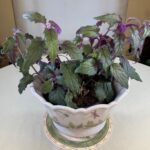A Little Pruning will Whittle Away Houseplant Woes |
In time, many houseplants will outgrow their space or become straggly and unbalanced.
Pruning and pinching creates a healthy, attractive indoor garden, encourages new growth and corrects structural problems. Done early enough, it will keep a plant the right size and shape for its space. Light trimming and reshaping can be done any time of the year, but more heavy pruning should be done during fall or spring.
Although not all houseplants need pruning, most will benefit from some attention, even if it’s simply removing dead leaves or diseased or damaged stems. Groomed plants are less likely to get pests and diseases. Cut judiciously. A good pruning job is barely noticeable. Keep in mind that it takes a long time for a major stem to be replaced, so when in doubt, don’t cut.
Pruning tools: Use high-quality bypass pruners or very sharp scissors. Dull pruners will crush or tear stems, leaving the plant vulnerable to disease. Poor pruning may also inhibit regrowth.
Kind cuts: Large, woody plants, like Norfolk Island pine and Ficus benjamina, tend to require pruning. When unsure about a particular plant, consult a houseplant encyclopedia. To shape a woody plant, proceed slowly and step back periodically to view your handiwork. Check that you are pruning it according to the natural growth habit of the plant. Shorten leggy stems or branches that have grown awry. Always make clean cuts above a node, which is where a branch or leaf is or was attached.
There are dormant buds at each node. This is where the new growth will appear. If you must remove large stems, cut as close as possible to the main stem or all the way to the base.
Pinching back: Many smaller houseplants are herbaceous, which means they have soft stems. Such plants require some form of pinching back to keep them dense and shapely. Vining plants such as pothos produce trailing stems that can become lanky and leggy, with long gaps between leaves. When you shorten such stems by pinching off the growing tips, this stimulates latent side buds in the leaf nodes into bushy growth.
Generally, your thumb and forefinger make good pinchers because most new growth is tender. If not, use pruners or sharp scissors. Always pinch just above a leaf node. Some plants require regular pinching, while others need it only once or twice a year. Use care when pruning plants that flower so that you don’t cut off any buds. Get to know the flowering cycle of your plant before doing any pinching.
Plants that do best with regular pinching include polka dot plant (hypoestes), iresine, vining philodendron (Philodendron scandens), pothos, coleus, grape ivy (cissus), tradescantia, abutilon, inch plant (callisia), creeping Jennie (lysimachia), Swedish ivy (plectranthus) and arrowhead plant (syngonium). Some flowering plants that require pinching or pruning are lipstick plant (aeschynanthus), which should be pruned back to about one-third after flowering.
To encourage reflowering in columnea, cut back older branches by one-third to one-half in spring. Other plants that may need pruning if they get too large include dieffenbachia, which should be cut back if it becomes leggy, and some of the tall-growing draceanas. When shortening a dracaena, cut the cane at an angle so that no water will settle on the stump and cause rotting. Depending on the size of the cane you cut down, one to three or four side shoots will come up and begin growing, making it a shorter, bushier plant.



